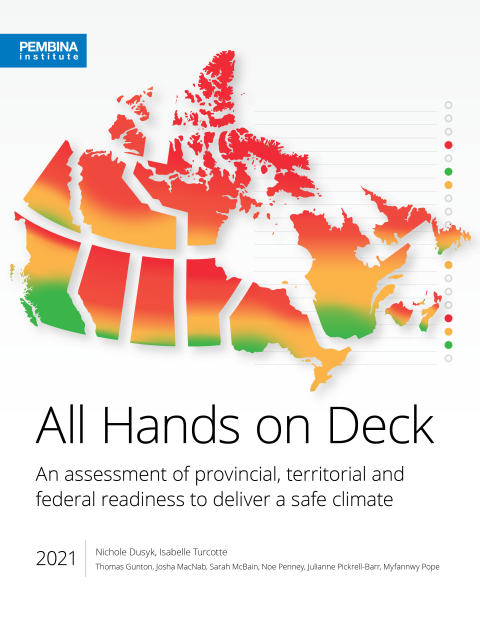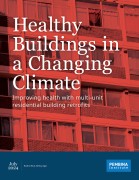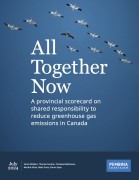Unlocking a prosperous future for all will require bold, ambitious action on climate from governments across Canada.
To measure readiness to act on climate, Pembina Institute in collaboration with Simon Fraser University’s School of Resource and Environmental Management assessed the performance of provinces, territories, and the federal government on 24 policy indicators across 11 categories. The indicators represent foundational climate policies and measures to reduce emissions in key sectors of the economy. Governments were invited to review the accuracy and completeness of the data and summary for their region prior to publication.
The assessment shows that there have been important examples of climate leadership and success across the country. Yet, progress made — for example with economy-wide carbon pricing and the phase-out of coal-fired electricity — has been offset by emissions increases elsewhere. In particular, emissions from transportation and oil and gas production have been on a steady upward trajectory since 2005. As a result, Canada’s overall greenhouse gas (GHG) emissions have dropped by only 1% between 2005 and 2019. Modelling that includes the federal climate policy published in December 2020 shows a national emissions reduction of 36% below 2005 levels by 2030 — still short of the federal government’s commitment to reduce emissions by 40-45% by 2030.
Success requires all hands on deck. Although the federal government has set 2030 and 2050 targets, an assessment of climate policy across jurisdictions reveals that 50% of national emissions, including emissions from Alberta, Saskatchewan and Manitoba, are not covered by a provincial or territorial 2030 target. Almost three-quarters (74%) of national emissions, including emissions from Alberta, Ontario, Saskatchewan and Manitoba, are not covered by a provincial or territorial 2050 target.
The approach to climate action in Canada is piecemeal. It also lacks accountability for governments who promise climate action but don’t have timelines or policies to match the urgency of the situation. Despite the fast-approaching 2030 target, 95% of emissions generated in Canada are not covered by either a provincial or territorial 2030 target or climate plans independently verified to deliver on the 2030 target. No jurisdiction has developed pathways to describe how net-zero can be achieved.
Unfortunately, the increased incidence of record-breaking heat waves and wildfires — with their devastating impact on human health and community stability — are the inevitable result. Our findings show that Canada’s governments are unprepared to help deliver a safe climate. Given their jurisdiction over energy resources, provinces and territories hold much of the power to change this situation. It’s time for every Canadian province and territory to step up action to ensure a safe and sustainable future for all.
Climate success does not require a uniform approach for every province and territory. In this report, based on evaluation of the indicators, we have identified specific priorities for action for each province, territory, and the federal government.
In addition, we have identified six areas of action and 16 recommendations that all governments can implement, if they have not already done so. These include putting in place a climate policy framework to deliver fair and ambitious climate action and ensure that emissions are decreasing in all sectors, especially the largest emitters.
Six actions urgently needed across Canada
1. Set higher emissions reduction targets and shrinking carbon budgets. Governments prepared to deliver on climate promises will:
- Commit to net-zero emissions by 2050 and model a pathway to achieve that goal
- Commit to a 2030 target aligned with Canada’s historic contribution and ability to mitigate climate change
- Translate targets into carbon budgets.
2. Make governments accountable. Accountability requires that federal, provincial and territorial governments:
- Create an independent accountability body, and mandate independent evaluation and advice to the legislature, not the government of the day
- Legislate targets and carbon budgets for regular, short-term milestones between 2021 and 2050
- Mandate a requirement that climate mitigation plans, including actions to achieve legislated milestones, adaptation plans and evaluations, are tabled in their respective legislatures.
3. Prioritize reconciliation and equity. To begin the process of building reconciliation and equity into climate policy, governments need to:
- Pass legislation committing to full implementation of the United Nations Declaration on the Rights of Indigenous Peoples
- Commit to monitoring, publicly reporting on, and mitigating the impacts of climate change and climate change policy on Indigenous Peoples and their rights
- Commit to monitoring, publicly reporting on, and mitigating the gendered, socio-economic and racial impacts of climate change and climate change policy.
4. Set economy-wide sectoral budgets and map net-zero pathways. In nearly every province and territory, either oil and gas or transportation (or both) are the largest source of emissions. As such, governments need to:
- Set economy-wide sectoral budgets and strategies at national, provincial, and territorial levels
- Prioritize emissions reductions in the highest-emitting sectors
- Decarbonize electricity by 2035.
5. Plan for a decline in oil and gas. The federal government, and governments in fossil fuel-producing provinces and territories, need to:
- Create transition plans for the oil and gas sector that are based on net-zero pathways and include comprehensive strategies to ensure a just and inclusive transition.
6. Accelerate the push to decarbonize transportation. Governments need to:
- Mandate 100% zero-emission vehicle (ZEV) sales by 2035 and provide incentives for purchase and infrastructure
- Develop decarbonization strategies for medium- and heavy-duty vehicles and goods movement
- Develop and fund public transit and active transportation strategies.









